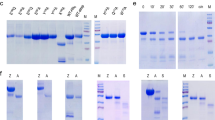Abstract.
This review describes the structure and function of prolyl endopeptidase (PEP) enzymes and how they are being evaluated as drug targets and therapeutic agents. The most well studied PEP family has a two-domain structure whose unique seven-blade β-propeller domain works with the catalytic domain to hydrolyze the peptide bond on the carboxyl side of internal proline residues of an oligopeptide substrate. Structural and functional studies on this protease family have elucidated the mechanism for peptide entry between the two domains. Other structurally unrelated PEPs have been identified, but have not been studied in detail. Human PEP has been evaluated as a pharmacological target for neurological diseases due to its high brain concentration and ability to cleave neuropeptides in vitro. Recently, microbial PEPs have been studied as potential therapeutics for celiac sprue, an inflammatory disease of the small intestine triggered by proline-rich gluten.
Similar content being viewed by others
Author information
Authors and Affiliations
Corresponding author
Additional information
Received 6 July 2006; received after revision 17 August 2006; accepted 1 November 2006
Rights and permissions
About this article
Cite this article
Gass, J., Khosla, C. Prolyl endopeptidases. Cell. Mol. Life Sci. 64, 345–355 (2007). https://doi.org/10.1007/s00018-006-6317-y
Published:
Issue Date:
DOI: https://doi.org/10.1007/s00018-006-6317-y




